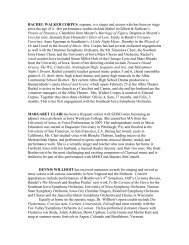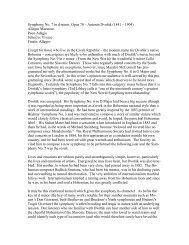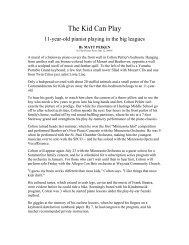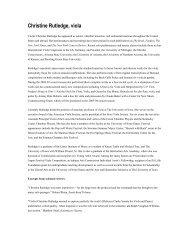57 fall program - Southeast Iowa Symphony Orchestra
57 fall program - Southeast Iowa Symphony Orchestra
57 fall program - Southeast Iowa Symphony Orchestra
Create successful ePaper yourself
Turn your PDF publications into a flip-book with our unique Google optimized e-Paper software.
Program Notes<br />
by Jim Priebe<br />
<strong>Symphony</strong> No. 7 in d minor, Opus 70<br />
Antonin Dvořák (1841 – 1904)<br />
Allegro Maestoso<br />
Poco Adagio<br />
Scherzo: Vivace<br />
Finale: Allegro<br />
Program Notes<br />
Except for those who live in the Czech Republic – the modern name for Dvořák’s native Bohemia<br />
– concertgoers are likely to be unfamiliar with much of Dvořák’s music beyond the <strong>Symphony</strong><br />
No. 9 in e minor (From the New World) the wonderful b minor Cello Concerto, and the<br />
Slavonic Dances. Those who regularly attend concerts by the <strong>Southeast</strong> <strong>Iowa</strong> <strong>Symphony</strong> are<br />
exceptions, however, since Maestro McConnell has <strong>program</strong>med not only the aforementioned<br />
works but the <strong>Symphony</strong> No. 8 in G Major and now the Seventh as well. In this writer’s opinion<br />
our audience is well-served by this <strong>program</strong>ming since Dvořák wrote a great deal of music<br />
which deserves to be heard more frequently. Certainly the <strong>Symphony</strong> No. 7 <strong>fall</strong>s into this category:<br />
many believe that it is Dvořák’s finest symphony (Ted Libbey calls it “one of the nineteenth<br />
century’s greatest symphonic scores”), the popularity of the New World <strong>Symphony</strong> notwithstanding!<br />
Dvořák was energized. His <strong>Symphony</strong> No. 6 in D Major had been a big success (though it was<br />
regarded as being more important as a work in the Bohemian national style than a work of international<br />
standing). He had been greatly inspired by the 1883 premier of Brahms’ <strong>Symphony</strong> No.<br />
3 and was motivated to compose a work of similar stature which would closely follow classical<br />
conventions and avoid, he hoped, the parochial Bohemian label. His Stabat Mater had been a<br />
sensation when introduced in England in 1883 and there he had, in the words of Michael<br />
Steinberg, become “beloved and revered like no composer since Mendelssohn.” The Royal<br />
Philharmonic Society had invited him to conduct concerts in London in 1884, his first appearances<br />
as a conductor outside his own country, and he had been received with great warmth and<br />
enthusiasm. The Society invited him to compose a new symphony to be performed the following<br />
year and the <strong>Symphony</strong> No. 7 was the result.<br />
Lives and emotions are seldom purely and unambiguously simple, however, particularly the<br />
lives and emotions of artists. Energized he may have been, but Dvořák was also troubled. His<br />
(Continued on page 29)<br />
27






